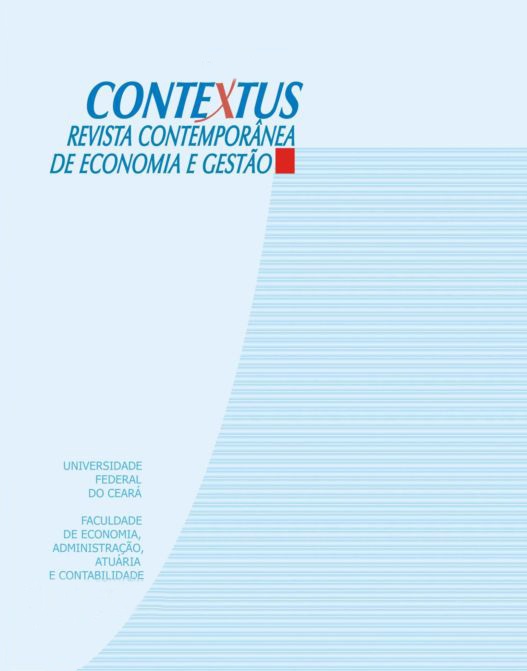RELATIONSHIP QUALITY IN ELECTRONIC COMMERCE (LA CALIDAD DE LA RELACIÓN DEL COMERCIO ELECTRÓNICO)
DOI:
https://doi.org/10.19094/contextus.v14i1.788Palabras clave:
Comercio electrónico. Valor percibido. Calidad de la relación. Compromiso. Confianza.Resumen
La innovación tecnológica permite diferentes estrategias para asistir a los deseos y necesidades de los clientes. En comparación con las tiendas físicas tradicionales, el comercio electrónico ofrece un acceso más fácil y un proceso de búsqueda para el comprador, que les permite encontrar la oferta más adecuada, en relación con las marcas, precio, entrega y transporte de mercancías. Este panorama aumenta el desafío para los vendedores para desarrollar un marketing de calidad de la relación con sus clientes en lugar de un enfoque de marketing transaccional, que a veces significa una sola compra. Este artigo informa la construcción de un modelo para medir la calidad de la relación entre los consumidores y vendedores de comercio electrónico, la exploración de las variables demográficas, actitud, de comportamiento y de lealtad hacia la compra electrónica, valor percibido, de compromiso, satisfacción y confianza. Una encuesta con una muestra no probabilística de una base de datos de una empresa de comercio electrónico brasileña en un periodo de 2009 a 2013. Los resultados iniciales han llevado a ampliar la investigación para incluir el valor percibido, el compromiso, la satisfacción y la confianza utilizando modelos de ecuaciones estructurales.Citas
AL-ALAK, B. A. Impact of marketing activities on relationship quality in the Malaysian banking sector. Journal of Retailing and Consumer Services. v. 21n. 3, p. 347-356. 2014.
ALDERSON, W. Marketing Behavior and Executive Action. ed. Homewood: Richard D. Irwin Inc, 1957.
ANDERSON, E.; WEITZ, N. The use of pledges to build and sustain commitment in distribution channels. Journal of Marketing Research, v.29, n.2, p. 18-34,1992.
ATHANASOPOULOU, P. Relationship quality: a critical literature review and research agenda. European Journal of Marketing, v. 43, n.5/6, p. 583-610, 2009.
BANDURA, A. Social learning theory. ed. Englewood Cliffs: Prentice Hall, 1977.
BANDURA, A. Self-efficacy in changing societies , p. 1-45. ed. New York: Cambridge University Press, 1995
BANDURA, A. Self-Efficacy: The exercise of control. ed. New York: W.H.Freeman,1997.
BASU, A.; MUYLLE, S. Online support for commerce processes by web retailers. Decision Support Systems, v. 34, n. 4, p. 379-9. 2003.
BENNETT, R.; BARKENSJO, A. Relationship quality, relationship marketing and client perceptions of the levels of service quality of charitable organisations. International Journal of Service Industry Management, v. 16, n.1, p. 81-106, 2005.
BERRY, L.; PARASURAMAN, A. Marketing Services. Ed. New York: The Free Press, 1991.
BLACKWELL, R. D.; MINIARD, P. W.; ENGEL, J. F., (2001), Consumer behavior. ed. Fort Worth, London: Harcourt College Publishers, 2001.
BRAZILIAN INTERNET STEERING COMMITTEE. ICT Households and Enterprises 2013. Access: <http://cetic.br/media/docs/publicacoes/2/TIC_DOM_EMP_2013_livro_eletronico.pdf> 2014.
BRENGMAN, M.; GEUENS, M.; WEIJTERS, B.; SMITH, S.M.; SWINYARD, W.R. Segmenting internet shoppers based on their web-usage-related lifestyle: a cross-cultural validation. Journal of Business Research, v.58, n.1, p.79-88, 2005.
BROCKNER, J. Self-esteem at work. ed. Lexington: Lexington Books,1988.
CACERES, R. C.; PAPAROIDAMIS, N.G. Service quality, relationship satisfaction, trust, commitment and business-to-business loyalty. European Journal of Marketing, v.41,n.7/8, p. 836-866, 2007.
CHIN, W. W. The partial least squares approach to structural equation modeling. In Modern methods for business research, Marcoulides,G.A, ed. p. 295-336. Mahwah: Lawrence Erlbaum Associates, 1998.
DABHOLKAR, P. A. Consumer Evaluations of New Technology-Based Self-Service Options: An Investigation of Alternative Models of Service Quality. International Journal of Service Research, v.13, p. 20-51, 1996.
DABHOLKAR, P. A., P. A.; BAGOZZI, R. P. An attitudinal model of technology based self-service.Moderating effects of consumer traits and situational factors. Journal of Academy of Marketing Science, v.30, n.3, p. 184-201, 2002.
DORSCH, M. J.; SWANSON, S. R.; KELLEY, S. W. The role of relationship quality in the stratification of vendors as perceived by customers. Journal of the Academy of Marketing Science, v.26, n.2, p. 128-142, 1998.
DOWLING, G. R.; UNCLES, M. Do customer loyalty programs really work? Sloan Management Review, v. 38, p.71-82, 1997.
EGGERT, A.; ULAGA, W. Customer perceived value: a substitute for satisfaction in business markets? Journal of Business & Industrial Marketing, v.17, n.2/3, p.107-118, 2002.
EGGERT, A.; ULAGA, W.; SCHULTZ, F. Value creation in the relationship life cycle: A quasi-longitudinal analysis. Industrial Marketing Management, v. 35, n.1, p. 20-27,2006.
FORNELL, C.; LACKER, D.F. Evaluating structural equation models with unobservable variables and measurement error. Journal of Marketing Research, v. 18, n(1), 39-50,1981.
GARBARINO, E.; JOHNSON, M. S. The Different Roles of Satisfaction, Trust, and Commitment in Customer Relationships. Journal of Marketing, v.63, n.2, p.70-87, 1999.
GOLDSMITH, R. E.; BRIDGES, E. E-tailing vs. retailing.Using attitudes to predict online buying behavior. Quarterly Journal of Electronic Commerce, v. 1,n.3, p.245-253, 2000.
GOOGLE SHOPPER MARKETING AGENCY COUNCIL. Mobile In-store Research: How In-store Shoppers Are Using Mobile Devices, Access: , 2013.
GRANT, D. B. UK and US management styles in logistics: Different strokes for different folks? International Journal of Logistics: Research and Applications, v.7,n.3, p. 181-197, 2004.
GRÖNROOS, C. Service logic revisited: Who creates values and who co-creates? European Business Review, v. 20, n.4, p. 298-314, 2008.
GUNDLACH, G. T.; ACHROL, R. S.; MENTZER, J. T. The Structure of Commitment in Exchange. Journal of Marketing, v. 59, n.1, p.78-92,1995.
HAIR, J.F.; ANDERSON, R.E.; TATHAN, R.L.; BLACK, W.C. AnáliseMultivariada de Dados. ed.Porto Alegre: Editora Bookman, 2005.
HENSELER, J.; RINGLE, C. M.; SINKOWICS, R. R. The use of partial least squares path modeling in international marketing. Advances in International Marketing, n.20, p. 277-319, 2009.
HEWETT, K.; MONEY, R. B.; SHARMA, S. An exploration of the moderating role of buyer corporate culture in industrial buyer-seller relationships. Journal of the Academy of Marketing Science, v.30, n.3, p.229-239, 2002.
HIBBARD, J. D.; KUMAR, N.; STERN, L. W. Examining the impact of destructive acts in marketing channel relationships. Journal of Marketing Research, v.38, n.1, p. 45-61, 2001.
HIRSCHMAN, E. C. Innovativeness, novelty seeking and consumer creativity. Journal of Consumer Research, v.7, n.3, p.283-295, 1980.
HOFFMAN, L.; NOVAK, T.; SCHLOSSER, A. The evolution of the digital divide: how gaps in internet access may impact electronic commerce. v. 5, n. 3, 2000.
HOLBROOK, M. B. The nature of customer value. In Service Quality: New Directions. In Theory and Practice., Rust, R. T. and Oliver, R. L. ed., p. 21-71. Thousand Oaks: Sage Publications, 1994.
HULLANK, J. Use of Partial Least Square (PLS) in strategic management research: A review of four recent studies. Strategic Management Journal, v.20, n.2, p. 195–204, 1999.
HUNTLEY, J. K. Conceptualization and measurement of relationship quality: linking relationship quality to actual sales and recommendation intention. Industrial Marketing Management, v.35, n.6, p. 703-714, 2006.
KANTER, R. M. Confidence: How winning and losing streaks begin and end. ed. NewYork: Crown Publishing, 2006.
LINDGREEN, A.; HINGLEY, M. K.; GRANT, D. B.; MORGAN, R. E., Value in business and industrial marketing: Past, present, and future. Industrial Marketing Management, v.41,n.1, p. 207-214, 2012.
LUNENBURG, F. Self-efficacy in the workplace: implications for motivation and performance. International Journal of Management, Business and Administration, v.14, n.1, 2011.
MEUTER, M. L.; OSTROM, A. L.; ROUNDTREE, R. I.; BITNER, M. J. Self-Service Technologies: Understanding Customer Satisfaction with Technology-Based Service Encounters. Journal of Marketing, v. 64, n.3, p. 50-64, 2000.
OLIVER, R. L. Satisfaction: A Behavioral Perspective on the Consumer, ed. New York: McGraw-Hill, 1997.
MÖLLER, K. Role of competences in creating customer value: A value-creation logic approach. Industrial Marketing Management, v.35, n.8, p. 913-924, 2006.
MOORMAN, C.; ZALTMAN, G.; DESHPANDÉ, R. Relationships between providers and user of marketing research: The dynamics of trust within and between organizations. Journal of Marketing Research, v. 29, n.3, p. 314-329, 1992.
MOORMAN, C.; DESHPANDÉ, R.; ZALTAMAN, C., Factors affecting trust in market research relationships. Journal of Marketing, v.57, n.1, p. 81-101, 1993.
MORGAN, R. M.; HUNT, S. D. The commitment-trust theory of relationship marketing. Journal of Marketing, v.58, n.3, p. 20-38, 1994.
PARASURAMAN, A.; ZEITHAML, V. A.; BERRY, L. SERVQUAL: a multiple-item scale for measuring consumer perceptions of service quality. Journal of Retailing, v.64, n.1, p. 12-40, 1988.
PECK, J.; CHILDERS, T. L. Individual differences in haptic information processing: the “Need forTouch” Scale. Journal of Consumer Research, v.30, n.3, p. 430-442, 2003.
RAVALD, A.; GRÖNROOS, C. The value concept and relationship marketing. European Journal of Marketing, v.30, n.2, p. 19-30, 1996.
RIGBY, D. K.; REICHHELD, F. F.; SCHEFFER, P. Avoid the four perils of CRM. Harvard Business Review, v. 81, p. 5-11, 2002.
SHARMA, S.; NIEDRICH, R. W.; DOBBINS, G. A Framework for Monitoring Customer Satisfaction: An Empirical Illustration. Industrial Marketing Management, n.28, p. 231-243, 1999.
SHETH, J. N.; MITTAL, B.; NEWMAN, B. Customer behavior: consumer behavior and beyond. ed. Fort Worth: Dryden Press, 1999.
SHUI, E.; DAWSON, J. Comparing the impacts of technology and national culture on online usage and purchase from a four country perspective. Journal of Retailing and Consumer Services, v. 11, n.6, p. 385-394, 2004.
SIMNO, F.; USUNIER, J. C. Cognitive, Demographic, and Situational Determinants of Service Customer Preference for Personnel-in-Contact over Self-Service Technology. International Journal of Research in Marketing, v.24, n.2, p. 163-173, 2007.
SIRDESHMUKH, D.; SINGH, J.; SABOL, B. Consumer Trust, Value, and Loyalty in Relational Exchanges. Journal of Marketing, v.66, n.1, p. 15-37, 2002.
SLYKE, C.V. Gender differences in perceptions of web-based shopping. Communications of the ACM, v.47, n.7, p. 82-86, 2002.
SRINIVASAN, S.; ANDERSON, R.; KISHORE, P. Customer loyalty in e-commerce: an exploration of its antecedents and consequences. Journal of Retailing, v.78, n.1, p. 41-50, 2002.
ULAGA, W.; EGGERT, A. Relationship value and relationship quality. Broadening the nomological network of business-to-business relationships. European Journal of Marketing, v.40, n.3/4, p. 311-327, 2006.
VAN DER BIJL, J. J.; SHORTRIDGE-BAGGETT, L. M. The theory and measurement of the self-efficacy construct. In Self-efficacy in nursing: Research and measurement perspectives, Lentz, E. A. and Shortridge-Baggett, L. M. ed. p. 9-28. New York: Springer, 2002.
WEBSTER, F. E. Jr. Understanding the relationships among brands, consumers, and resellers. Journal of the Academy of Marketing Science, n. 28 (Winter), p. 17-23, 2000.
WOODRUFF, R. B. Customer value: The next source of competitive advantage. Journal of the Academy of Marketing Science, v.25, n.2, p. 139-153, 1997.
WULF, K.; ODEKERKEN-SCHRODER, D.; IACOBUCCI, D. Investments in consumer relationships: a cross-country and cross-industry exploration. Journal of Marketing, v.65, n.4, p. 33-50, 2001.
ZHOU, L., DAI, L.; ZHANG, D. Online shopping acceptance model: a critical survey of consumer factors in online shopping. Journal of Electronic Commerce, v.8, n.1, p.41-62, 2007.
Descargas
Publicado
Cómo citar
Número
Sección
Licencia
Os autores, no ato da submissão, aceitam a declaração abaixo:
Nós autores mantemos sobre nosso artigo publicado os direitos autorais e concedemos à revista Contextus o direito de primeira publicação, com uma licença Creative Commons na modalidade Atribuição – Não Comercial 4.0 Internacional, a qual permite o compartilhamento com reconhecimento da autoria e da publicação inicial nesta revista.
Temos ciência de estarmos autorizados a assumir contratos adicionais separadamente, para distribuição não exclusiva da versão do trabalho publicada nesta revista (ex.: publicar em repositório institucional ou como capítulo de livro), também com reconhecimento tanto da autoria, quanto da publicação inicial neste periódico.
Atestamos que o artigo é original ou inédito, não foi publicado, até esta data, em nenhum periódico brasileiro ou estrangeiro, quer em português, quer em versão em outra língua, nem está encaminhado para publicação simultânea em outras revistas.
Sabemos que o plágio não é tolerado pela revista Contextus e asseguramos que o artigo apresenta as fontes de trechos de obras citadas, incluindo os de qualquer trabalho prévio produzido e publicado pelos próprios autores.









3.png)


1.jpg)



1.jpg)


1.jpg)






.jpg)



1.jpg)

1.jpg)


1.jpg)

1.jpg)
1.jpg)
2.png)




1.jpg)
2.jpg)

1.jpg)





1.jpg)


1.jpg)
1.jpg)
